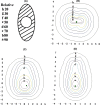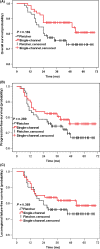Preliminary report of a single-channel applicator in high dose rate afterloading brachytherapy for cervical cancer
- PMID: 30353607
- PMCID: PMC6272109
- DOI: 10.1111/cas.13845
Preliminary report of a single-channel applicator in high dose rate afterloading brachytherapy for cervical cancer
Abstract
The aim of this study was to evaluate whether a patented single-channel applicator, which was modified from the traditional tandem applicator and wrapped with an oval-shield alloy around the source channel, has the same clinical efficacy and safety as the standard Fletcher-type applicator in high dose rate (HDR) brachytherapy for carcinoma of the cervix. Between December 2011 and February 2017, 299 patients with pathologically confirmed International Federation of Gynecology and Obstetrics (2009) stage Ib2-IVa cervical cancer were recruited to the trial and finished the allocated intervention. Of the first 151 patients, 71 were allocated to the Fletcher group and 80 to the single-channel group, satisfying the criteria for a preliminary analysis. All but 3 patients were treated with concurrent cisplatin chemotherapy and external beam radiotherapy followed by HDR brachytherapy. The 2-year overall survival, progression-free survival, and locoregional failure-free survival was 80.3%, 77.5%, and 78.9%, respectively, for the Fletcher group, and 86.3%, 82.5%, and 83.8%, respectively, for the single-channel group. The seriousness of acute treatment-related toxicities was similar in the 2 groups. The cumulative rate of late rectal complications of grade 3-4 in the Fletcher group and the single-channel group was 2.8% and 2.5%, respectively. The cumulative rate of grade 3 bladder complications was 2.8% for the Fletcher group and 1.3% for the single-channel group. The preliminary results of our study show that the patented single-channel intracavitary applicator might be able to provide protection for the rectum and bladder and seems to have the same clinical efficacy as the standard Fletcher-type 3-channel applicator in HDR brachytherapy for carcinoma of the cervix. This trial was registered with the Chinese Clinical Trial Registry (registration no. ChiCTR-TRC-12002321).
Keywords: cervical carcinoma; clinical trial; concurrent chemoradiotherapy; high dose rate brachytherapy; radiotherapy.
© 2018 The Authors. Cancer Science published by John Wiley & Sons Australia, Ltd on behalf of Japanese Cancer Association.
Figures




Similar articles
-
Phase II study of concurrent chemoradiotherapy with high-dose-rate intracavitary brachytherapy in patients with locally advanced uterine cervical cancer: efficacy and toxicity of a low cumulative radiation dose schedule.Gynecol Oncol. 2012 Aug;126(2):211-6. doi: 10.1016/j.ygyno.2012.04.036. Epub 2012 Apr 30. Gynecol Oncol. 2012. PMID: 22555110 Clinical Trial.
-
A dosimetric comparison between applicators used for brachytherapy in carcinoma cervix - A single-institute prospective study.Indian J Cancer. 2018 Jul-Sep;55(3):230-232. doi: 10.4103/ijc.IJC_659_17. Indian J Cancer. 2018. PMID: 30693884 Clinical Trial.
-
Concurrent chemoradiation for cervical cancer: Comparison of LDR and HDR brachytherapy.Brachytherapy. 2019 May-Jun;18(3):353-360. doi: 10.1016/j.brachy.2018.11.008. Epub 2019 Apr 7. Brachytherapy. 2019. PMID: 30971370 Free PMC article.
-
Treatment results of high-dose-rate remote afterloading brachytherapy for cervical cancer and retrospective comparison of two regimens.Int J Radiat Oncol Biol Phys. 2003 Apr 1;55(5):1254-64. doi: 10.1016/s0360-3016(02)04525-x. Int J Radiat Oncol Biol Phys. 2003. PMID: 12654435 Review.
-
American Brachytherapy Task Group Report: A pooled analysis of clinical outcomes for high-dose-rate brachytherapy for cervical cancer.Brachytherapy. 2017 Jan-Feb;16(1):22-43. doi: 10.1016/j.brachy.2016.03.008. Brachytherapy. 2017. PMID: 28109631 Free PMC article. Review.
Cited by
-
Clinical Outcomes of Volumetric Modulated Arc Therapy Following Intracavitary/Interstitial Brachytherapy in Cervical Cancer: A Single Institution Retrospective Experience.Front Oncol. 2019 Aug 16;9:760. doi: 10.3389/fonc.2019.00760. eCollection 2019. Front Oncol. 2019. PMID: 31475110 Free PMC article.
-
The value of PFS36 as a primary endpoint for radiotherapy trials in patients with LACC: individual patient data from the Chinese NCC and validation from 26 RCTs.J Natl Cancer Cent. 2025 Jan 9;5(2):193-202. doi: 10.1016/j.jncc.2024.08.003. eCollection 2025 Apr. J Natl Cancer Cent. 2025. PMID: 40265093 Free PMC article.
-
Early report on abbreviated brachytherapy schema for cervical cancer during the COVID-19 pandemic.J Contemp Brachytherapy. 2024 Dec;16(6):437-442. doi: 10.5114/jcb.2024.146515. Epub 2024 Dec 31. J Contemp Brachytherapy. 2024. PMID: 39943971 Free PMC article.
References
-
- Sankaranarayanan R. Overview of cervical cancer in the developing world. FIGO 26th Annual Report on the Results of Treatment in Gynecological Cancer. Int J Gynaecol Obstet. 2006;95(Suppl 1):S205‐S210. - PubMed
-
- Gaffney DK, Erickson‐Wittmann BA, Jhingran A, et al. ACR Appropriateness Criteria(R) on advanced cervical cancer expert panel on radiation oncology‐gynecology. Int J Radiat Oncol Biol Phys. 2011;81(3):609‐614. - PubMed
-
- Al Feghali KA, Elshaikh MA. Why brachytherapy boost is the treatment of choice for most women with locally advanced cervical carcinoma? Brachytherapy. 2016;15(2):191‐199. - PubMed

